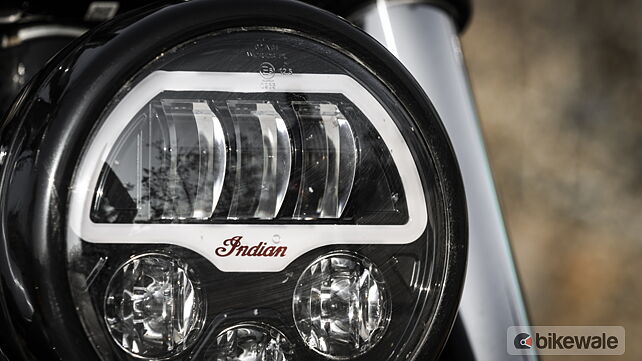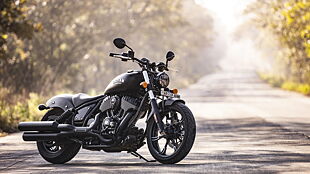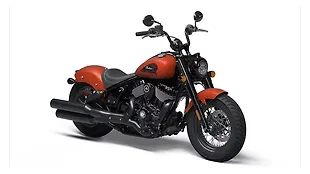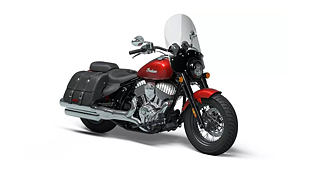Introduction

Indian Motorcycle is an American brand that silently exists in India with seven dealerships across the country. Plus, its cruiser models can easily be mistaken for the more popular Harley due to their similar American design and thumping V-twin engines.
But then the huge 'Indian' lettering on the fuel tank loudly announces it is a different brand with a different philosophy, story, and a unique product line-up. A line-up with a variety of tourers and cruisers, one of which is the Chief Dark Horse. The one you see in these pictures is the 2022 edition with a host of changes. Now, to understand its place and purpose in the Indian market, we spend some time riding and living with this behemoth of a motorcycle.
What's New?

Well, a lot. Starting with the design, minimalism is the name of the game here. Gone are the large swooping fenders and headlamp bezel, making way for a smaller naked headlamp and chopped fenders. However, this hasn't robbed it of its grandeur; the all-black theme, thoroughly exposed chassis, dual shotgun-style exhausts, and chunky tyres turn quite a few heads on the road.

Where a welcoming change has taken place is in the technology department. The highlight here is the four-inch, circular TFT screen that packs in a surprising amount of data for a modern-retro offering. Firstly, there are two theme options for the main screen — one that shows various parameters in a concise format and the other, cleaner one, displaying just the basic stuff.

Apart from the odometer and trip meters, you have the option to monitor information about each ride individually. This 'Current Ride' screen shows figures like distance covered, ride time, and elevation. The screen can also be connected to your smartphone for accessing music control, getting calls and messages notifications, and navigation. I couldn't test the Bluetooth since the dash isn't compatible with the latest iteration of OnePlus phones, I am told. Dang!

Anyway, what's impressive is that the screen is touch-sensitive while it can also be fiddled with through the buttons on the switchgear. And then with bits like auto-brightness adjustment, it comes across as too modern a setup on a retro-styled machine.
Other modern features include a full-LED lighting setup, keyless ignition, USB charging port, cruise control, and ABS. There are three riding modes too! Choosing one amongst touring, standard, and sport mode essentially alters the throttle response without tinkering with the power output.

Now, let's look at a few numbers because they play an important role in the overall riding experience. The Chief is extremely long with a wheelbase of 1,626mm, sits low with a ground clearance of 125mm, and is super heavy at 304kg. How does all of this translate onto the road? Bear with me.
The motorcycle rides on a combination of 19-16-inch alloy wheels that are suspended by 132mm telescopic forks up front and 75mm preload-adjustable dual shocks at the rear. The stopping power comes from a 300mm disc at both ends.

As for the powerhouse, the Chief runs on a 1,890cc, V-twin, air-cooled engine that Indian calls the Thunderstroke 116. It produces a massive 162Nm of peak torque at as low as 3,200rpm. Sounds fun, no? It is.
The Ride

The engine comes to life with a mechanical cacophony and a deep gurgling exhaust sound. Wring the accelerator and it greets you with a thundering roar, which is typical of a big V-twin. Now, get past the vocal drama and roll, only to realise that the engine performs as good as it sounds.

The engine remains docile initially, but get past 2,000rpm, and a flood of torque is broken loose. The pull is relentless. It's brutal. It's manic. It's like an invisible force has whipped it hard at the back. The ferocious build-up of speed lasts until its redline of 5,000rpm. Interestingly, it is not just quick but the power delivery also feels smooth and clean. Even if you're sitting at 100kmph on the highway, overtakes require just a gentle prod.

Then, when you pull the brake lever, all the mayhem calms down at a brisk pace. Although it could do with harder stopping power, there's an acceptable and gradual bite from the front brake lever. Even the rear brake does a decent job of adding to the speed-shedding.
Now, switch to the Sport mode and you're in for even bigger and scarier surprises. The throttle becomes so direct that you're greeted with the rear wheel spin almost every time you take off spiritedly. It's difficult to ride sanely in this mode since the response from its ride-by-wire is outright choppy. Launching in a straight line is a quick and mind-bending affair. However, I had to be very careful while changing directions as vigorous wheel spins at slight acceleration kept giving me mini heart attacks, even on decently grippy surfaces.

What deserves a special mention is the rear cylinder deactivation feature. Every time the engine is left idling in traffic, the rear cylinder is automatically stalled till the time you get in motion and revs climb. Although the engine still heats up, it's never to the extent of causing agony.
The wheelspins don't quickly turn things upside down, courtesy of the long wheelbase and Pirelli rubbers that offer tremendous grip. The feedback from these tyres was commendable even while leaning the bike. After getting a hang of its hefty weight, large turning radius, and lazy steering, I had started scraping the pegs around familiar corners. Even in traffic, it feels surprisingly agile and manageable on the move.

The ride quality is equally impressive. Of course, given the short suspension travel and low ground clearance, high-amplitude undulations can be back-breaking. But at controlled speeds, rumblers and potholes are ironed out cleanly. While at high speeds, on clean sections of the highway, the bike doesn't lose composure.

What bothered me the most was the lack of comfort with the current setup. You undoubtedly look cool holding onto the flat and wide handlebar and stretching your legs out to reach the forward-set footpegs. However, the handlebar is too far to be comfortable, especially while taking U-turns. Placing your feet up and down the footpegs intermittently is also a difficult affair. Thanks to this whole setup, your backside digs into the seat and starts hurting within an hour of riding. This is where Indian's wide range of optional accessories like pulled-back handlebar, footboards, and touring seat come into the picture.
Verdict

The Indian Chief Dark Horse is a quintessential full-blown cruiser, or bobber, in a sense that it has very limited applications. With the stock setup, I would only take it to a nearby coffee shop on a weekend where I can show it off.
Long rides are out of the question until you install Indian's optional touring-focused pegs, bars, and a windscreen. And installing these elements will only increase the already steep price tag of Rs 20 lakh (ex-showroom). Since Harley-Davidson's similar-displacement models like the Fat Bob and Softail are priced much lesser, the Chief does seem expensive.

Nevertheless, the Thunderstroke 116 is a gem of an engine that plasters a wide grin on your face every time you gas it, no matter how experienced you are. The gallops of torque and roaring sound are truly addictive. Needless to mention, the Chief Dark Horse also scores high in the aesthetic department.
Photography by Kapil Angane
Gallery
1/135
Indian Chief Dark Horse Head Light
Double Tap to Zoom
















































![KTM 390 Adventure X [2025] KTM 390 Adventure X [2025]](https://imgd.aeplcdn.com/272x153/n/cw/ec/190885/390-adventure-x-2025-right-side-view.jpeg?isig=0&q=80)